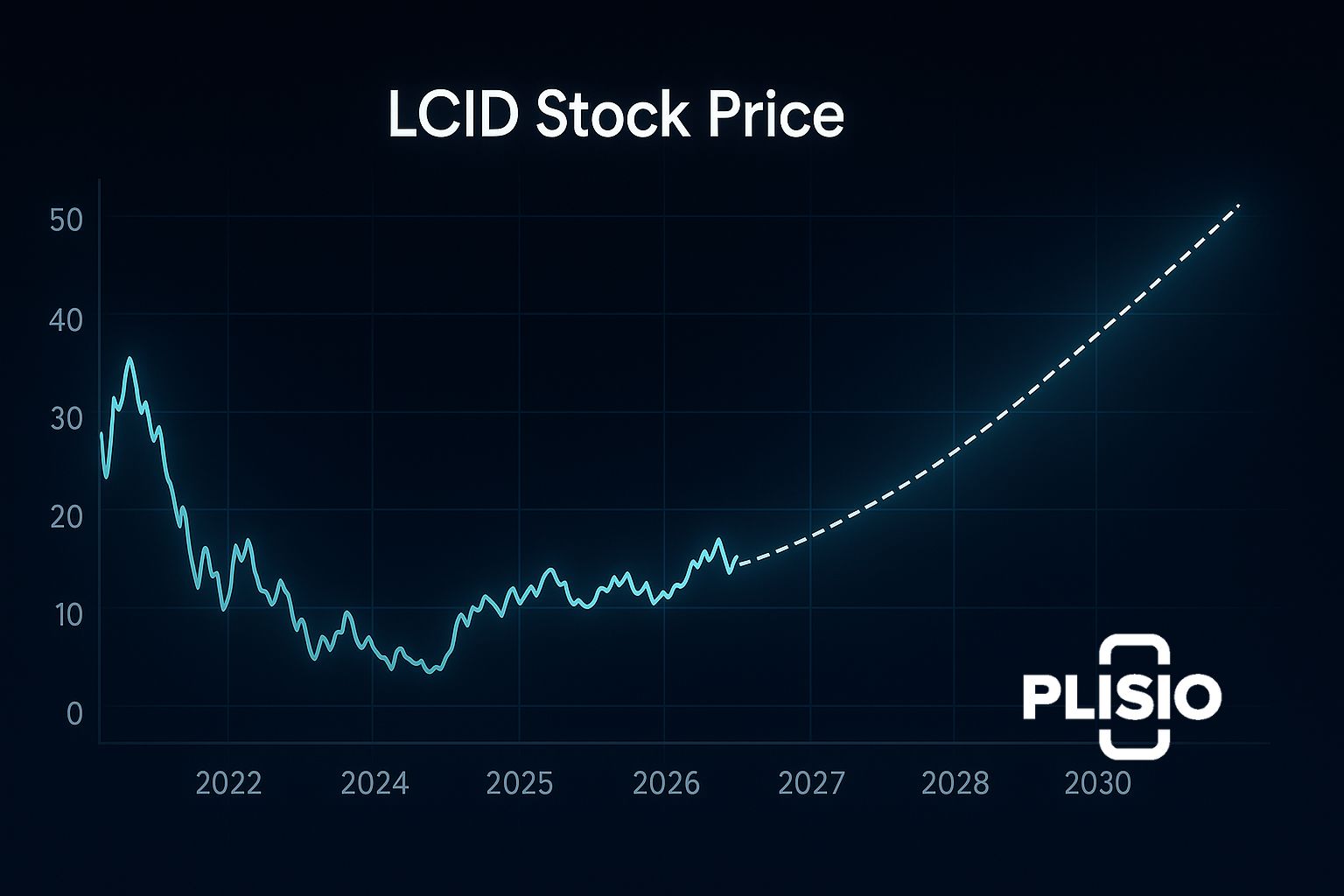Lucid Motors Price Prediction: LCID Stock Forecast for 2025, 2026, and 2030

Lucid Group has become one of the most discussed names in the electric vehicle space as investors search for new growth opportunities beyond Tesla. The company’s trajectory remains uncertain, but the combination of ambitious engineering, financial challenges, and shifting U.S. market conditions makes LCID one of the most fascinating stories on the Nasdaq. This article presents an in‑depth forecast for Lucid Group, using current price action, financials, moving averages, analyst price targets, and long‑term price predictions through 2030. All information reflects the most recent data, giving a grounded, up‑to‑date view of the lcid stock price outlook.
Lucid Group Overview: The EV Maker Reshaping Expectations
Lucid Group markets itself as a premium electric vehicle manufacturer, competing in a luxury space where design, performance, and battery efficiency are decisive. While it is still far from Tesla’s production scale, the company has positioned itself as a technological leader through its Air sedan, with additional programs in development including the Gravity SUV and future mass market models.
As an EV maker, Lucid aims not only to capture a slice of consumer demand but also to explore long‑term opportunities such as robotaxi integration and plug-in platform expansions. In the U.S. EV market, competition remains intense, with Tesla’s Model 3 and Model X continuing to dominate mainstream and premium categories. Even so, Lucid believes that engineering excellence and efficient battery systems can secure long‑term growth potential.
Current Price and Price Action
The current price of LCID fluctuates around the lower teens, reflecting mixed sentiment. Recent price action shows rapid swings driven by several recurring forces:
- Bearish macro trends: inflation cycles, rate pressure, and weakened tech-sector sentiment.
- Liquidity concerns: investor caution about dilution and long-term funding.
- Production variability: quarterly delivery numbers that frequently surprise to the upside or downside.
- EV sector volatility: shifting enthusiasm for EV makers compared with broader Nasdaq trends.
Lucid’s historical price over the past two years shows extended periods of decline, interrupted by temporary bullish rallies when investor enthusiasm spikes. Despite these fluctuations, Lucid shares remain actively traded across the Nasdaq and NYSE-adjacent market ecosystem.
Financials and Liquidity Concerns
Lucid’s financials paint a picture of a company investing heavily in long‑term capacity.
Highlights of Lucid’s current financial position:
- Negative EPS: the company remains unprofitable and far from positive cash flow.
- High operational costs: manufacturing expansion and R&D continue to outweigh revenue.
- Large backing from PIF: providing stability but also raising dilution concerns.
- Capital‑intensive roadmap: future models and factory expansion require ongoing funding. EPS remains deeply negative, and analysts frequently warn that shareholders may lose money in the near term unless profitability improves. The company’s liquidity position is stable for now due to backing from the Public Investment Fund, but further dilution is possible.
A major turning point arrived with Lucid’s 1‑for‑10 reverse split, which aimed to restore compliance and lift the post‑split share price into a more respectable range. Post-split trading has remained volatile, illustrating both opportunity and risk.

Technical Analysis and Moving Averages
From the perspective of technical analysis, LCID remains below key moving averages, reflecting a bearish sentiment trend. Short-term traders note frequent breakdowns below support levels, while long‑term investors focus on accumulation patterns and macro cycles.
Still, technical indicators alone cannot define a company’s fate, especially when the overall market remains sensitive to inflation, interest rates, and EV incentives.
Analyst Ratings, Analyst Price Targets, and Consensus
Analysts remain divided on Lucid’s future. Many highlight the disconnect between Lucid’s valuation and its modest delivery figures, resulting in a blend of Hold, sell rating, and strong sell recommendations. A minority of analysts maintain bullish expectations, arguing that Lucid’s brand and engineering could justify a rebound.
The consensus rating today leans toward cautious neutrality. Even so, the range of analyst price targets provides useful context. The average price target for Lucid varies by institution but tends to fall between the high teens and mid‑twenties. The average price target represents analysts’ expected 12‑month valuation and reflects both financial risk and projected improvements.
Below is a table summarizing a hypothetical aggregation of analyst price target predictions:
|
Outlook Category |
Analyst Price Target |
Interpretation |
|
High Forecast |
30.00 |
Optimistic production growth, stronger margins |
|
Average Forecast |
$18–25 |
Modest improvement in financials |
|
Low Forecast |
$10–12 |
Continued cash burn and production setbacks |
These price targets echo the mixed analyst sentiment, ranging from strong buy in rare bullish cases to strong sell where concerns dominate.
Latest Forecasts for 2025
A grounded financial forecast places LCID within a wide range due to its uncertain execution timeline. Yet most stock forecast models cluster around moderate improvement.

The stock price prediction for 2025 generally lands between $18 and $20 if Lucid increases production and delivers consistent quarter‑over‑quarter growth. A delayed ramp‑up could keep the short-term price near its current level. A bullish scenario with strong Gravity SUV demand could push prices above $25.
LCID Stock Forecast for 2026
By 2026, Lucid may have additional models on the road and greater manufacturing efficiency. In such conditions, LCID could rise toward the mid‑twenties. However, a negative shift in financial markets, rising competition from EVs, or a macroeconomic downgrade could suppress recovery.
A second table captures different modeling outcomes:
|
Scenario |
2026 Price Range |
Key Assumptions |
|
Bullish |
$28–32 |
Gravity scaling, better margins, stronger demand |
|
Base |
$20–25 |
Moderate growth, stable U.S. incentives |
|
Bearish |
$10–15 |
Weak EV demand, liquidity strain |
Prediction for 2030
The prediction for 2030 depends on Lucid’s ability to expand globally and compete in new categories. If the company captures meaningful market share, integrates advanced autonomous systems, and successfully enters the mass market segment, LCID could trade in the $35–50 range. A weaker trajectory could leave the stock closer to its present levels.
Competitive Landscape: Tesla, EVs, and Market Conditions
Competition from Tesla remains a defining factor. The Model 3 and Model X reinforce Tesla’s chokehold on the EV mid‑range and premium categories. Meanwhile, emerging EVs from China and Europe pressure all U.S. EV startups.

Lucid’s future therefore depends not only on production but also on dynamic market conditions, consumer incentives, and regulatory policies.
Price Points and Valuation Context
Lucid’s valuation remains debated. Some investors argue that its engineering leadership and battery innovations justify long‑term optimism. Others highlight that Lucid trades at a valuation disconnected from its output.
Regardless, monitoring price points, volatile price action, and earnings cycles helps investors contextualize long‑term opportunities.
Benzinga, Motley Fool, and Media Commentary
Financial commentary outlets contribute greatly to sentiment. Motley Fool writers such as Ryan Vanzo have produced mixed assessments, balancing enthusiasm for the brand against concerns about capital burn. Benzinga provides regular analyst updates and rating shifts that affect short-term volatility.
CoinCodex and Other Forecast Models
Some algorithmic tools like CoinCodex generate automated projections for LCID’s trajectory. These models often rely on historical data and technical trends, making them useful but not definitive.
Impact on Shareholders and the U.S. Market
For every Lucid shareholder, the coming years promise uncertainty and potential reward. The broader U.S. EV infrastructure push could assist Lucid if consumer adoption accelerates, particularly in luxury segments.
Recommendation Trends and Long-Term Outlook
Current recommendation trends show cautious optimism from some analysts, deep skepticism from others, and a large middle ground of Holds. Over time, improvements in quality, scale, and margin structure could shift sentiment.
Conclusion
Lucid Group’s trajectory remains one of the biggest open questions in the modern EV landscape. The company has the engineering to impress, the funding to survive, and the ambition to expand. Whether these strengths translate into sustainable profitability by 2025, 2026, or 2030 will determine whether LCID becomes a long-term winner or remains a speculative play on the Nasdaq.
In this evolving story, one truth is clear: the road ahead is as electrifying as the cars themselves.
